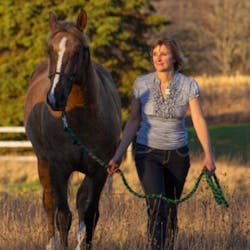How horses can help your dental practice incorporate the ‘fifth element’
This article originally appeared in the Principles of Practice Management e-newsletter. Subscribe to this informative twice monthly practice management ENL here.
A dentist-client recently invested in a team retreat with my horses. I own and operate Braveheart Equine Coaching. When the dentist checked in, she mentioned feeling alone and experiencing the crushing stress of “doing it all herself.” I was curious. Her team appeared to be talented and committed. What was missing?
Noticing a pattern in the team dynamics, I set a horse loose in the arena and told the dentist, “That horse represents your practice. Guide her back to us. Everything in this arena is a resource, however, you may not touch, scare, or bribe the horse to come along.”
She selected a dressage whip with a flag on the end as an aid, and strode toward Bailey, the horse, who was exploring the arena’s furthest corner. Bailey trotted away whenever the dentist came close. The more this client tried to move her, the more Bailey resisted. Their mutual frustration was palpable.
Put down the whip
Then something important shifted. The dentist put down the whip. In response, Bailey bucked exuberantly, paused, turned, and approached to stand quietly in face-to-face acceptance. You can watch the pivotal moment here.
When you’re constantly driving, it’s easy to feel like you’re the only one making things happen. Others naturally resist pressure, which impedes flow. Dentists are hard wired to push ourselves and our teams, but this is exhausting for everyone.
Working with horses has repeatedly taught me that it’s the release, not the application of pressure, that yields the greatest results. The release creates an opportunity for connection and trust, where we can invite the horse to join us in partnership. It’s the same when we’re working with people. Sometimes we just need to put down the whip.
Ask for help
Once Bailey accepted the invitation to connect, my client’s joy was apparent, until Bailey took a detour and then the dynamic immediately shifted. My client applied pressure, Bailey declined to comply, and frustration replaced joy.
I called a timeout while my client thought through what was happening. I repeated, “Everything in this arena is a resource for you.” She nodded, eyeing the props lined up along the wall. As she walked away, her team exploded and said, “When are you going to ask us to help?” and “Stop ignoring us!”
The dentist stopped in her tracks, mortified. I asked, “How familiar is this?” They responded unanimously that this was a direct reflection of the practice. The dentist had wisely surrounded herself with a capable and committed team but was not leaning on them. Instead, she applied pressure, never thinking to ask for help. As a result, they felt underappreciated and underutilized, while she felt lonely, stressed, and overburdened.
Aware of all of this, I asked her to repeat the challenge. This time, she successfully reconnected with Bailey and deployed team resources to help move the horse in a non-coercive way.
Dr. Bethany Piziks Gareiss guides one of her therapy horses around the grounds of Braveheart Equine Coaching.
Create safety
This exercise highlighted the necessary shift needed to take this team from good to great. Google researchers recently listed characteristics of exceptional teams.[i] This practice nailed four of the five attributes.
1. Dependability—Tasks were accomplished on time and expectations were met.
2. Structure and clarity—They had clear individual goals and well-defined roles.
3. Meaning—Everyone agreed their work had personal significance.
4. Impact—They now believe their work is purposeful and has a positive impact.
However, they did not incorporate the fifth element, which is psychological safety. The team did not feel safe enough to voice opinions or engage in positive conflict, while the dentist didn’t feel safe enough to be vulnerable and trust her team to have her back.
This awareness allowed us to create experiences that drove powerfully positive shifts. In the psychological safety of the arena, everybody stepped up with courage and authenticity, inspired by their leader’s willingness to go first and go all in. They built trust by sharing challenging experiences and deep personal truths, and by limiting beliefs. The horses supported the work with their characteristic grace, encouraging the team to find compassion for themselves and each other. The result was a more cohesive and honest team who is committed to providing their patients and each other with more connection and support, and a dentist who can finally lean in and allow her practice to flourish.
You go first
Dentists in private practice are not sole practitioners. You don’t get to do it all yourself. Creating exceptional teams requires an emotionally mature leadership practice and a psychologically safe environment for everybody, including the dentist. You must go first and lead by example. Being vulnerable, and encouraging that in others, takes bravery. That’s where a 1,200 pound being can teach you all you need to know.
For the most current practice management headlines, click here.
For the most current dental headlines, click here.
Reference



